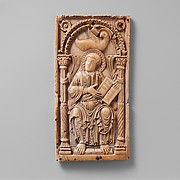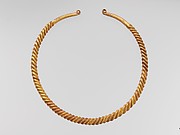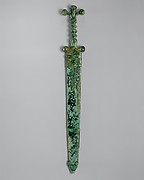The German word Palmesel (palm donkey) refers to the statue of Christ on a donkey, mounted on a wheeled platform, which was part of Palm Sunday processions in many German-speaking regions until the Reformation.
Featured Artwork of the Day: Palmesel | 15th century | Germanhttp://met.org/1AnpOc9
*****
http://www.metmuseum.org/about-the-museum/museum-departments/curatorial-departments/medieval-art-and-the-cloisters
Medieval Art and The Cloisters

The Museum's collection of medieval and Byzantine art is among the most comprehensive in the world. Displayed in both the Main Building and in the Metropolitan's branch in northern Manhattan, The Cloisters museum and gardens, the collection encompasses the art of the Mediterranean and Europe from the fall of Rome in the fourth century to the beginning of the Renaissance in the early sixteenth century. It also includes pre-medieval European works of art created during the Bronze Age and early Iron Age.
Main Building
More than fourteen hundred objects on view in the Main Building allow visitors to trace the history of medieval and Byzantine Art, from their roots in Celtic and late Roman art to the sumptuous objects of late medieval courts and the ecclesiastical riches of Late Byzantium and its eastern neighbors. The collection boasts an abundance of works from Late Antiquity and the Early Byzantine periods. The renowned Second Cyprus Treasure, with its plates representing the life of the biblical King David, is one of several silver and gold treasures on view. Byzantine Egypt is particularly well represented by an impressive collection of textiles as well as architectural fragments and tomb monuments from the Museum's early twentieth-century excavations at Bawit and Saqqara. An extensive collection of early medieval art, which comprises the jewelry of Anglo-Saxons, Franks, and Visigoths among other peoples, highlights the artistic achievements of western Europe at the same moment.
An evocation of a Byzantine church sanctuary, replete with icons and a lectionary from the church of Hagia Sophia, makes plain the Museum's rich collection of art from the Greek East from 800–1500. The same period in the Latin West saw the emergence of the Church as the most important patron of the arts, and several galleries testify to the splendid holdings of western monasteries and churches. Relic containers, book covers, and a tabernacle are among the many noteworthy objects from the Museum's collection of enamels by Limoges goldsmiths. A set of works from eleventh- and twelfth-century Spain includes ivory carvings and leaves from a Beatus manuscript. Masterworks of sculpture and stained glass from such key monuments as the royal abbey of Saint-Denis outside Paris, Notre-Dame in Paris, and the cathedral of Amiens evoke the great age of church building. Also on view is an array of ivories from the Gothic period, while luxury tableware and a rotating display of tapestries recall the world of late medieval aristocrats.
The Cloisters Museum and Gardens
The Cloisters museum and gardens, the Metropolitan's branch museum dedicated to the art and architecture of medieval Europe, is located on four acres overlooking the Hudson River in northern Manhattan's Fort Tryon Park. It is named for the portions of cloisters from present-day France—Saint-Michel-de-Cuxa, Saint-Guilhem-le-Désert, Trie-sur-Baïse, Froville, and elements once thought to have come from Bonnefont-en-Comminges—that were incorporated into a modern museum building. Three of the cloisters (Cuxa, "Bonnefont," and Trie) feature gardens—planted according to horticultural information found in medieval treatises and poetry, garden documents, and herbals. The overall effect is not a copy of any specific medieval structure but rather a harmonious and evocative setting for approximately two thousand works of art, a rich selection of objects and architectural elements from the medieval west largely dating from the twelfth through the fifteenth century.
The Treasury contains small-scale works of exceptional splendor. On display is a richly carved English ivory cross of the twelfth century, as well as the Hours of Jeanne d'Evreux, a masterpiece in miniature by the illuminator Jean Pucelle, and a book of hours created for the great medieval book collector, Jean of France, Duke of Berry. A gallery devoted to late medieval private devotion presents the celebrated Merode Triptych by the Netherlandish master Robert Campin. The Late Gothic Hall exhibits many of the finest fifteenth- and sixteenth-century works in the collection, including sculptures by Tilman Riemenschneider and altarpieces from Spain. Particularly beloved is the gallery that features the seven tapestries showing The Hunt of the Unicorn. Throughout The Cloisters are exceptional examples of stained-glass windows, including those from the castle chapel at Ebreichsdorf, Austria, and the Carmelite church at Boppard-am-Rhein.




沒有留言:
張貼留言